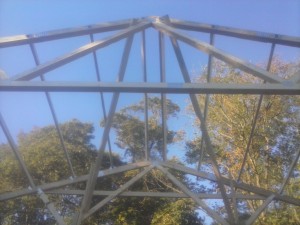Yes – sliding doors can end up being placed on a roof…..just not on purpose!
The photo is of a sliding door on a Morton Building owned by a friend of a Hansen Pole Buildings employee. As this is an older building, it is not intended to be a negative commentary on any of the current buildings being constructed by Morton Buildings.
Considering the tremendous number of pole buildings Morton Buildings has constructed over the years, there are truly relatively few negative commentaries on the ‘net in regards to problems or issues faced by Morton Buildings’ owners.
 There are some issues with this sliding door which I would like to point out, ones which could be from nearly any pole building provider – not just Morton Buildings.
There are some issues with this sliding door which I would like to point out, ones which could be from nearly any pole building provider – not just Morton Buildings.
Note what appears to be a 2×6 “top rail” or top girt of the sliding door. Sliding doors with wood members tend to be heavy, as well as the top rail is most probably under designed to be able to adequately carry the weight of the sliding door, without (at the least) some sagging occurring. This is not the reason for the failure of this door.
Properly designed, sliding doors should have a metal bottom girt (or bottom rail) which interlocks with a steel guide rail which is mounted to the pressure preservative treated skirt board (splash plank) in the direction the door slides. In most cases, this, in itself, should have prevented the door from flopping over onto the roof.
For the sliding door to have ended up where it is, the latches on the door (one at the jamb and the other to the other leaf of the door) must not have been properly latched by the building owner. There also should have been a steel guide mounted to either the concrete floor or to a stubbed column set in concrete between the sliding door leaves at the bottom. When properly closed, the sliding door leaves would be tight into this guide.
Besides the obvious (the sliding door now located on the roof), once the sliding door literally blew up, the building now became a partially enclosed building. The wind forces applied to the members of a partially enclosed building are much greater than those of a fully enclosed building. Think of the opening as now being the “throat” of a balloon and the building as being the balloon itself. These added, and undersigned for, forces, could easily have contributed to the failure of some or all of the building.
In this case, the Morton Building owner was actually lucky – all which needs to be done is to repair or replace the sliding door track, hardware and the door itself!






